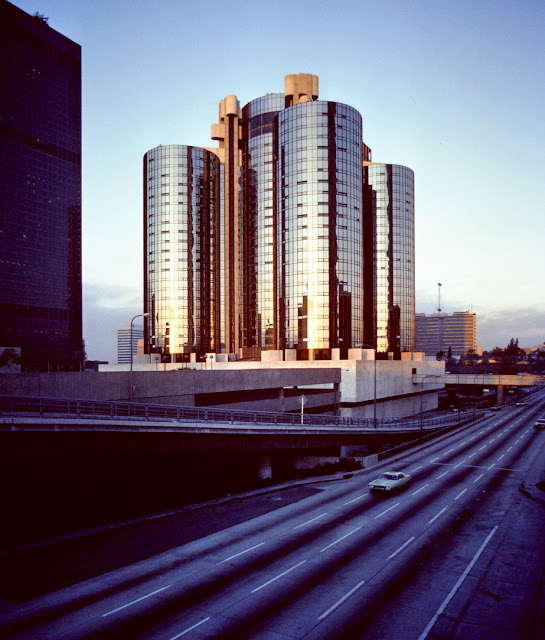Skyscrapers are our country's most visible, iconic buildings, and LA has some beauties designed between 1899 and the present day. The first skyscraper was actually built in Chicago in 1885. Since then, they have grown taller and more dramatic, progressing through visible design changes depending on the decade. Learning to spot these design eras was the goal of my recent LA Skyscraper Train Tour (in addition to just plain having fun!).
| My wonderful tour group admiring skyscrapers on Bunker Hill. |
So let's cut to the chase. So here are the major design eras of LA's and the nation's "'scrapers"!
1) First Stage - Beaux Art: Building as Column: A Three-Part Classical Design - Early American skyscraper designers were often trained at the Paris School of Fine Arts ("Beaux Art") where they were encouraged to articulate their buildings with classical features. In many cases, the building's composition was that of a classical column with its three-part design: base (often embellished with enhanced entry, larger windows and surface decoration); shaft (a fairly plain, elongated middle of the building); and capital (a richly detailed "crown" with a cornice and window pediments).
| Typical modern skyscraper from 1973 and one of first on Bunker Hill in LA. Recessed vertical windows were somewhat unique for this time period. A.C. Martin & Assoc. Architects. |
| LA Public Library - notice the stepped-up, ziggurat look from the 1920s - dwarfed by the twin Arco Towers - International Style skyscrapers from 1972. |
 |
| John Portman's dramatic reflective glass skyscrapers of the 1970s. |
 |
| Skyscrapers from 1980s on LA's Bunker Hill show various shapes and materials. |
 |
| Classic 80s example of "breaking up the box" and reflective glass. |
| LA's Bunker Hills shows gorgeous late modern skyscrapers from the 1980s and 90s. |
7. Stage 6: Post-Modernism - 1980s The period of architecture called "post modern" also influenced skyscrapers. This period featured playful cultural, historical and contextual references in buildings and clearly moved away from the austere glass curtain wall of the 50s and 60s. One of the best examples is Phillip Johnson's ATT Building in NYC which featured a chippendale top or cornice. It's hard to design subtle cultural references 800 feet in the air though, so post-modern skyscrapers were few and far between.
 |
| Phillip Johnson's ATT Building in New York City, with its fanciful Chippendale top, is the classic example of skyscraper postmodernism. |
 |
| One PPG Place, built in 1981, is a good example of post modernism. Its pointed parapets and vertical emphasis evokes Gothic architecture, all with modern materials. |
 |
| LA's best example of a post-modern skyscraper is the US Bank Building. Its stepped-up volumes and accordion-style top evokes Art Deco designs. |
| LA's tallest building, the Wilshire Grand, has a curving top with a spire. The City changed its 40-year-old flat roof requirement for helicopter pads. Bring on the fun shapes, architects! |
| Helipads are longer required on LA skyscrapers as fire suppression technology and building technology have improved. |
| Irvine's 400 Spectrum towers use translucent, glazed and insulated glass for energy efficiency and beauty. |
 |
| Many modern residential skyscrapers have interesting surface articulation with balconies, vertical piers and varying colors. |
Stage 1 - Skyscrapers as three-part columns - 1890 - 1920
Stage 2 - Skyscrapers as cathedrals and palaces 1910 - 1920
Stage 3 - Skyscrapers as stepped-up, decorative ziggurats 1925 - 1935
Stage 4 - Skyscrapers as rectangular, flat-topped boxes - 1950 - 1970
Stage 5 - Skyscrapers as reflective glass, irregular shapes - 1965 - 1980
Stage 6 - Skyscrapers as playful cultural symbols 1980 - 1990
Stage 7 - Skyscrapers as high tech, complex articulated beauties - 1990 to present.
Look up, my friends, for now you can read the skyline! See you on the next tour!




